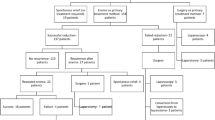Abstract
Purposes
Early recurrent ileocolic intussusception (RICI) is a rare event. We aimed to estimate the rate of RICI and identify predisposing factors for early recurrence for children treated in a tertiary-care academic medical center.
Methods
Consecutive children who were diagnosed with ileocolic intussusception (ICI) during the years 2005–2015 and had successful enema reduction were included. Demographic, clinical, imaging, and laboratory data were recorded for analysis. Ultrasound and fluoroscopy images were reviewed. Early RICI was defined as recurrence within 48 h.
Results
Two hundred forty-five episodes of intussusception in 210 patients, ages 2 to 77 months (mean 12.7), were included. Six patients (2.45%) had a RICI between 7 and 28 h (mean 17 h) after initial successful reduction. A total of 5/6 recurrences (83.3%) were in winter months. In the group without early recurrence, only 19.6% of the cases presented during the winter (p = 0.001). Mean age in the early recurrence group was 23 months compared to 12.4 months children with no early recurrence (p = 0.016). All other analyzed parameters were comparable for the groups.
Conclusion
Early RICI is a relatively rare event that may not justify routine admission and long observation. The approach should be individual, based on the clinical picture.
Similar content being viewed by others
References
Fleisher GR, Ludwig S (2006) Textbook of pediatric emergency medicine, 5th edn. Lippincot, Williams & Wilkins, Philadelphia
Eklöf O, Reiter S (1978) Recurrent intussusception analysis of a series treated with hydrostatic reduction. Acta Radiol Diagn 19:250–258
Lui KW, Wong HF, Cheung YC, See LC, Ng KK, Kong MS, Wan YL (2001) Air enema for diagnosis and reduction of intussusception in children: clinical experience and fluoroscopy time correlation. J Pediatr Surg 36:479–481
Daneman A, Alton DJ, Lobo E, Gravett J, Kim P, Ein SH (1998) Patterns of recurrence of intussusception in children: a 17-year review. Pediatr Radiol 8:913–919
Chien M, Willyerd FA, Mandeville K, Hostetler MA, Bulloch B (2013) Management of the child after enema-reduced intussusception: hospital or home? J Emerg Med 44:53–57
Bajaj L, Roback MG (2003) Postreduction management of intussusception in a children’s hospital emergency department. Pediatrics 112:1302–1307
Fecteau A, Flageole H, Nguyen LT, Laberge JM, Shaw KS, Guttman FM (1996) Recurrent intussusception: safe use of hydrostatic enema. J Pediatr Surg 31:859–861
Gilmore AW, Reed M, Tenenbein M (2011) Management of childhood intussusception after reduction by enema. Am J Emerg Med 29:1136–1140
Wang Z, He QM, Zhang H, Zhong W, Xiao WQ, Lu LW, Yu JK, Xia HM (2015) Intussusception patients older than 1 year tend to have early recurrence after pneumatic enema reduction. Pediatr Surg Int 31:855–858
Menor F, Cortina H, Marco A, Olague R (1992) Effectiveness of pneumatic reduction of ileocolic intussusception in children. Gastrointest Radiol 17:339–343
Kim JH, Lee JS, Ryu JM, Lim KS, Kim WY (2017) Risk factors for recurrent intussusception after fluoroscopy-guided air enema. Pediatr Emerg Care:1. https://doi.org/10.1097/PEC.0000000000001071
Al-Jazaeri A, Yazbeck S, Filiatrault D, Beaudin M, Emran M, Bütter A (2006) Utility of hospital admission after successful enema reduction of ileocolic intussusception. J Pediatr Surg 41:1010–1013
Eshel G, Barr J, Heiman E, Bistritzer T, Broide E, Klin B, Aladjem M (1997) Incidence of recurrent intussusception following barium versus air enema. Acta Paediatr 86:545–546
Ein SH (1975) Recurrent intussusception in children. J Pediatr Surg 10:751–755
Le Masne A, Lortat-Jacob S, Sayegh N, Sannier N, Brunelle F, Cheron G (1999) Intussusception in infants and children: feasibility of ambulatory management. Eur J Pediatr 158:707–710
Raval MV, Minneci PC, Deans KJ, Kurtovic KJ, Dietrich A, Bates DG, Rangel SJ, Moss RL, Kenney BD (2015) Improving quality and efficiency for intussusception management after successful enema reduction. Pediatrics 136:1345–1352
Gray MP, Li SH, Hoffmann RG, Gorelick MH (2014) Recurrence rates after intussusception enema reduction: a meta-analysis. Pediatrics 134:110–119
Lioubashevsky N, Hiller N, Rozovsky K, Segev L, Simanovsky N (2013) Ileocolic versus small-bowel intussusception in children: can US enable reliable differentiation? Radiology 269:266–271
Daneman A, Navarro O (2004) Intussusception part 2: an update on the evolution of management. Pediatr Radiol 34:97–108
Jiang J, Jiang B, Parashar U, Nguyen T, Bines J, Patel MM (2013) Childhood intussusception: a literature review. PLoS One 8:e68482
Serayssol C, Abbo O, Mouttalib S, Claudet I, Labarre D, Galinier P, Bouali O (2014) Seasonal pattern of intussusceptions in infants and children: is fall/winter predominance still worth consideration? A 10-year retrospective epidemiological study. Arch Pediatr 21:476–482
Champoux AN, Del Beccaro MA, Nazar-Stewart V (1994) Recurrent intussusception risks and features. Arch Pediatr Adolesc Med 148:474–478
Justice FA, Nguyen LT, Tran SN, Kirkwood CD, Thi NT, Carlin JB, Bines JE (2011) Recurrent intussusception in infants. J Paediatr Child Health 47:802–805
Niramis R, Watanatitan S, Kruatrachue A, Anuntkosol M, Buranakitjaroen V, Rattanasuwan T, Wongtapradit L, Tongsin A (2010) Management of recurrent intussusception: non-operative or operative reduction. J Ped Surg 45:2175–2180
Author information
Authors and Affiliations
Corresponding author
Ethics declarations
Conflict of interest
The authors declare that they have no conflict of interest.
Ethical approval
All procedures performed in studies involving human participants were in accordance with the ethical standards of the institutional research committee and with the 1964 Helsinki declaration and its later amendments or comparable ethical standards. For this type of study formal consent is not required.
Rights and permissions
About this article
Cite this article
Simanovsky, N., Issachar, O., Koplewitz, B. et al. Early recurrence of ileocolic intussusception after successful air enema reduction: incidence and predisposing factors. Emerg Radiol 26, 1–4 (2019). https://doi.org/10.1007/s10140-018-1635-6
Received:
Accepted:
Published:
Issue Date:
DOI: https://doi.org/10.1007/s10140-018-1635-6




